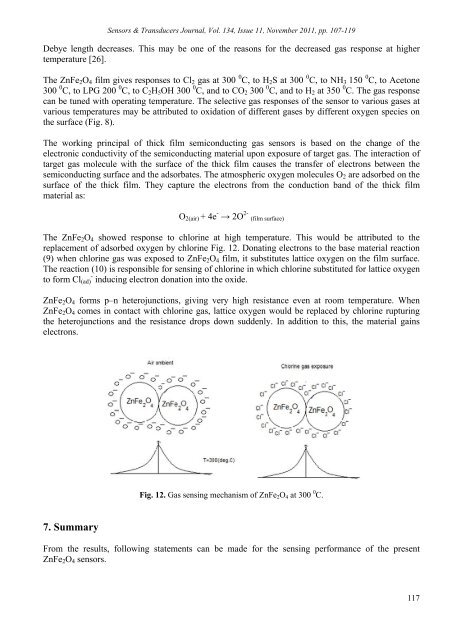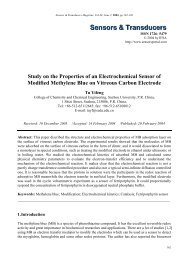Sensors & Transducers Journal, Vol. 134, Issue 11, November 2011, pp. 107-119Debye length decreases. This may be one <strong>of</strong> <strong>the</strong> reasons <strong>for</strong> <strong>the</strong> decreased gas response at highertemperature [26].The ZnFe 2 O 4 film gives responses to Cl 2 gas at 300 0 C, to H 2 S at 300 0 C, to NH 3 150 0 C, to Acetone300 0 C, to LPG 200 0 C, to C 2 H 5 OH 300 0 C, and to CO 2 300 0 C, and to H 2 at 350 0 C. The gas responsecan be tuned with operating temperature. The selective gas responses <strong>of</strong> <strong>the</strong> sensor to various gases atvarious temperatures may be attributed to oxidation <strong>of</strong> different gases by different oxygen species on<strong>the</strong> surface (Fig. 8).The working principal <strong>of</strong> thick film semiconducting gas sensors is based on <strong>the</strong> change <strong>of</strong> <strong>the</strong>electronic conductivity <strong>of</strong> <strong>the</strong> semiconducting material upon exposure <strong>of</strong> target gas. The interaction <strong>of</strong>target gas molecule with <strong>the</strong> surface <strong>of</strong> <strong>the</strong> thick film causes <strong>the</strong> transfer <strong>of</strong> electrons between <strong>the</strong>semiconducting surface and <strong>the</strong> adsorbates. The atmospheric oxygen molecules O 2 are adsorbed on <strong>the</strong>surface <strong>of</strong> <strong>the</strong> thick film. They capture <strong>the</strong> electrons from <strong>the</strong> conduction band <strong>of</strong> <strong>the</strong> thick filmmaterial as:O 2(air) + 4e - → 2O 2- (film surface)The ZnFe 2 O 4 showed response to chlorine at high temperature. This would be attributed to <strong>the</strong>replacement <strong>of</strong> adsorbed oxygen by chlorine Fig. 12. Donating electrons to <strong>the</strong> base material reaction(9) when chlorine gas was exposed to ZnFe 2 O 4 film, it substitutes lattice oxygen on <strong>the</strong> film surface.The reaction (10) is responsible <strong>for</strong> sensing <strong>of</strong> chlorine in which chlorine substituted <strong>for</strong> lattice oxygento <strong>for</strong>m Cl (ad) - inducing electron donation into <strong>the</strong> oxide.ZnFe 2 O 4 <strong>for</strong>ms p–n heterojunctions, giving very high resistance even at room temperature. WhenZnFe 2 O 4 comes in contact with chlorine gas, lattice oxygen would be replaced by chlorine rupturing<strong>the</strong> heterojunctions and <strong>the</strong> resistance drops down suddenly. In addition to this, <strong>the</strong> material gainselectrons.Fig. 12. Gas sensing mechanism <strong>of</strong> ZnFe 2 O 4 at 300 0 C.7. SummaryFrom <strong>the</strong> results, following statements can be made <strong>for</strong> <strong>the</strong> sensing per<strong>for</strong>mance <strong>of</strong> <strong>the</strong> presentZnFe 2 O 4 sensors.117
Sensors & Transducers Journal, Vol. 134, Issue 11, November 2011, pp. 107-119(I) Nanocrystalline ZnFe 2 O 4 has been syn<strong>the</strong>sized by self combustion route. This syn<strong>the</strong>sis route maybe used <strong>for</strong> <strong>the</strong> syn<strong>the</strong>sis <strong>of</strong> o<strong>the</strong>r metal oxide.(II) Among all o<strong>the</strong>r additives tested, ZnFe 2 O 4 is outstanding in promoting <strong>the</strong> ethanol gas sensingmechanism.(III) ZnFe 2 O 4 to be optimum and showed highest response to Chlorine vapours at 300 0 C.(IV)The sensor showed very rapid response and recovery to Chlorine vapours.(VI) Sensing mechanism <strong>of</strong> ZnFe 2 O 4 was <strong>the</strong> substitution <strong>of</strong> lattice oxygen by chlorine gas. Materialgains electrons in this substitution.(VII) The sensor has good selectivity to chlorine against acetone, NH 3 , LPG, ethanol, CO 2 , H 2 .References[1]. K. Arshak, E. Moore, G. Lyons, J. Harris, S. Clif<strong>for</strong>d, Sens. Rev., 24, 2004, pp. 181-191.[2]. L. Pirlola, H. Parviainen, T. Hussein, A. Valli, K. Hameri, P. Aaalta, A. Virtanen, J. Keskinen,T. A. Pakkanen, T. Makela, R. E. Hillamo, Atomos. Enviorn., 38, 2004, pp. 3625-3635.[3]. R. Nicolae, R. Elena, T. Florin, P. D. Popa, Sensors & Transducers, Vol. 78 Issue 4, 2007,pp. 1134-1142.[4]. X. Q. Liu, Z. L. Xu, Y. S. Shen, A new type ethanol material on CdFe 2 O 4 semiconductor, J. Yunnan Univ.,19, 1997, pp. 147-149.[5]. C. V. G. Reddy, S. V. Manorama and V. I. Rao, semiconducting gas sensor <strong>for</strong> chlorine based on inversespinel nickel ferrite, Sensors and Actuators B, 55, 1999, pp. 90-95.[6]. D. R. Patil, L. A, Patil, Room temperature Chlorine gas sensing using surface modified ZnO thick filmresistors, Sensors and Actuators B, 123, 2007, pp. 546-553.[7]. D. R. Patil, L. A. Patil P. P. Patil, Cr 2 O 3 -activated ZnO thick film resistors <strong>for</strong> ammonia gas sensingoperable at room temperature, Sens. Actuators B, 126, 2007, pp. 368-374.[8]. D. R. Patil, L. A. Patil, Al 2 O 3 - modified ZnO based thick film resistors <strong>for</strong> H 2 gas sensing, Sens.Transducers 81, 2007, pp. 1354-1363.[9]. D. R. Patil L. A. Patil, preparation and study <strong>of</strong> NH 3 gas sensing behavior <strong>of</strong> Fe 2 O 3 doped ZnO thick filmresistors, Sens. & Transducers, 70, 2006, pp. 661-670.[10]. G. H. Jain, L. A. Patil M. S. Wagh, S. A. Patil, D. R. Patil, D. P. Amalnerkar, Surface modified BaTiO 3thick film resistors as H 2 S gas sensor, Sens. Actuators B, 117, 2006, pp. 159-165.[11]. N. S. Chen, X. J. Yang, E. S. Liu and J. L. Huang, reducing gas-sensing properties <strong>of</strong> ferrite compoundsMFe 2 O 4 (M = Cu, Zn, Cd, Mg), Sensors and Actuators B, 66, 2000, pp. 178-180.[12]. C. V. Gopal Reddy, S. V. Manorama, V. J. Rao, preparation and characterization <strong>of</strong> ferrites as gas sensormaterials, J. Mater. Sci. Lett., 19, 2000, pp. 775-778.[13]. Z. Jiao, M. H. Wu, J. Z. Gu, Z. Qin, Preparation and gas sensing characteristics <strong>of</strong> nanocrystalline spinelzinc ferrite thin films, IEEE Sens. J., 3, 2003, pp. 435-438.[14]. X. S. Niu, W. P. Du, W. M. Du, Preparation and gas sensing properties <strong>of</strong> ZnM 2 O 4 (M = Fe, Co, Cr), Sens.and Actuators B, 99, 2004, pp. 405-409.[15]. X. F. Chu, X. Q. Liu, G. Y. Meng, Effect <strong>of</strong> CdO dopant on <strong>the</strong> gas sensitivity properties <strong>of</strong> ZnFe 2 O 4semiconductors, Sens. and Actuators B, 65, 2000, pp. 64-67.[16]. K. Arshak, I. Gaidan, Development <strong>of</strong> a novel gas sensor based on oxide thick film, Mater. Sci. Eng. B,118, 2005, pp. 44-49.[17] G. Zhang, C. Li, F. Cheng, J. Chen, ZnFe 2 O 4 tubes: Syn<strong>the</strong>sis and application to gas sensors, Sensors andActuators B, 120, 2007, pp. 403-410.[18]. G. Y. Zhang, B. Guo, J. Chen, MCo 2 O 4 (M = Ni, Cu, Zn), nanotubes, Sens. and Actuators B, 114, 2006,pp. 402-409.[19]. M. S. Wagh, G. H. Jain, D. R. Patil, S. A. Patil and L. A. Patil, Modified zinc oxide thick film resistors asNH 3 gas sensors, Sens. Actuators B, 115, 2006, pp. 128-133.118















